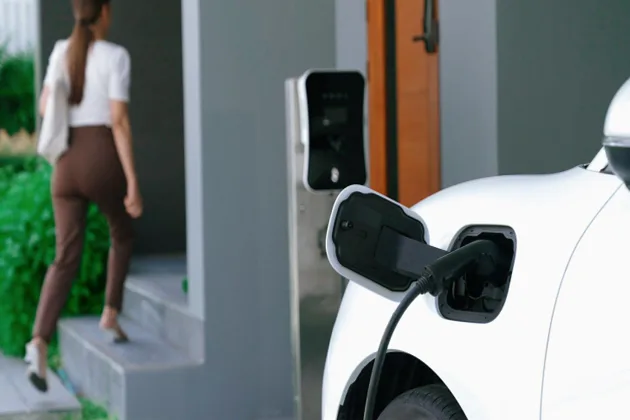Better technology, lower emissions, and that cool, futuristic atmosphere are the main reasons why electric vehicles (EVs) are becoming more and more common these days. Home charging is revolutionary for the majority of EV owners. The hitch is that connecting an EV charger isn’t the same as setting up a new coffee maker on your kitchen countertop.
It can shake things up with your home’s electrical system in ways you might not expect. In this article, we’ll break down what EV chargers are, how they affect your home’s electrical load, when you might need an upgrade, and some tips to keep everything running smoothly.
Understanding EV Chargers
First things first: what exactly are EV chargers? Technically called Electric Vehicle Supply Equipment (EVSE), these devices deliver power to your EV’s battery. They come in a few flavors, depending on how fast you want to charge:
- Level 1 Chargers: These plug into a standard 120-volt outlet — the kind you use for your toaster. They’re super convenient since you probably already have the outlet, but they’re slow. Charging a typical EV battery from empty might take a full day or more.
- Level 2 Chargers: These step things up with a 240-volt connection, like what your dryer or oven uses. They can juice up your EV in 4 to 8 hours, making them the popular pick for home charging.
- DC Fast Chargers: These are the speed demons you see at public stations, charging in under an hour. But they’re overkill for most homes due to their cost and massive power needs.
For most folks, Level 2 chargers hit the sweet spot. They’re fast enough to be practical but still manageable at home if your electrical system is up for it. That’s why professional Fuse Service EV charger installation can make all the difference in ensuring a smooth setup.
Impact on Home’s Electrical Load
The maximum amount of power that your home’s electrical system can manage at once is determined by a limit, expressed in amps. Consider it like a budget, into which devices, appliances, and lighting all contribute. Now consider incorporating an EV charger, particularly a Level 2 one capable of drawing 16 to 50 amps. It would be equivalent to operating two air conditioners simultaneously.
If your system’s already stretched thin, this extra demand could trip breakers or, worse, overheat wires. I’ve heard of people whose lights flicker like a horrible horror movie after plugging in their brand-new charger. The lesson learned? Prior to installation, you must determine whether your home’s electrical system can support the load or if additional upgrades are necessary.
Upgrading Your Electrical System for EV Charging
Older homes, especially those with 100-amp panels, might groan under the weight of an EV charger. Here’s what upgrading could look like:
- Bigger Electrical Panel: Swapping a 100-amp panel for a 200-amp one gives you more breathing room for electric vehicle charging without maxing out your system.
- Dedicated Circuit: A separate line just for your charger keeps it from fighting with your fridge or AC for power.
- New Wiring: Level 2 chargers need a 240-volt outlet, which might mean running fresh wires from your panel to your garage or driveway.
I’d never recommend tackling this yourself because electricity isn’t forgiving. A licensed electrician can check your setup and make it safe. For a seamless job, companies like Fuse Service offer EV charger installation that gets it right the first time. It’s worth the peace of mind knowing your home’s ready for the EV life.
Possible Risks and Precautions
EV chargers are safe when done right, but cut corners, and you’re asking for trouble. Overloading your system is a biggie. Push it too far, and you risk blown fuses or even fires. I’ve seen stories of DIY installs gone wrong, with sketchy wiring causing all sorts of headaches. Then there’s grounding — if it’s not done properly, you could get a nasty shock.
The fix? Hire a pro, period. Regular checkups on your system don’t hurt either. Oh, and a surge protector? That’s a small investment to shield your EV and home from random power spikes.
Home Energy Management and EV Charging


Charging an EV doesn’t have to mean chaos for your energy bill. A little planning goes a long way:
- Off-Peak Charging: Some power companies cut rates at night. Plug in then, and you’ll save cash while easing grid strain.
- Smart Chargers: These gadgets let you schedule charging, track usage, or even tap into solar power if you’ve got panels.
- Load Balancing: Fancy systems can juggle power, prioritizing your charger when the dishwasher’s not running.
I’ve got a friend who swears by his smart charger — says it’s like having a personal energy assistant. It’s all about keeping your home electrical system happy while your EV charges up.
In Conclusion
Bringing an EV charger into your home is a smart move: convenient, cost-effective, and future-proof. But it’s not plug-and-play. You’ve got to weigh how it hits your electrical load, decide if upgrades are in order, and manage energy like a pro. With the right prep and a trusted electrician (shoutout to Fuse Service for their EV charger installation expertise), you’ll be set to enjoy electric vehicle charging without a hitch. So, whether you’re already cruising in an EV or just dreaming of one, understanding this stuff now will keep your home powered up and ready for the road ahead.

